BODY HEART SOUL
Sunday, April 9, 2017
Thursday, February 2, 2017
Monday, January 2, 2017
Thursday, September 17, 2015
Learn How You Can Manage Your Chronic Pain
Don't allow pain to rule your life: Being a partner in managing your symptoms can make a big difference
It is rare that I meet anyone who truly can say they have no pain in their body.
I’ve given many thousands of lessons to patients and clients on how to self-treat their painful body parts — and now I realize that the best way to do this is by educating people on how to stop the cycle of pain, when and where it occurs. To be successful at abolishing pain, and particularly chronic pain, you must learn to become mindful of what you are feeling in your body, day and night.
For most people, their pain results from some kind of mechanical problem that may be causing radiating and in some cases debilitating symptoms. The McKenzie Method — a comprehensive care system used by physical therapists — classifies mechanical pain into three types:
Postural Syndrome
This is pain resulting from poor posture.
Derangement
The result of something displaced inside a joint or a spinal disk, this pain causes an obstruction in range of motion.
Dysfunction
This pain is a result of chronically shortened tissues in the joint tissues, as well as the tissues surrounding the joint.
Each of these conditions can be self-treated by implementing a proactive treatment using the McKenzie Method.
Where does the pain come from?
The quickest way to determine if your pain stems from a mechanical source is to visit a practitioner who has been trained in mechanical diagnosis and treatment (MDT). This method is predominantly used by physical therapists. The McKenzie Method has become the most effective treatment available for abolishing neck and low back pain of mechanical origin.
Developing mechanical pain
Mechanical pain can be caused from a single event, such as a sports injury, a fall or even be a post-surgical side effect.
It also can be due to a repetitive and chronic mechanical stressor, such as sitting at your computer with poor posture. Ever sat at a desk or in a car? Cleaned your house, done yard work or cared for children? Then you could develop mechanical pain.
Chemical pain vs. mechanical pain
It’s common for pain to stem from mechanical or chemical causes. Sometimes they occur at the same time. Knowing how to treat both kinds of pain can be crucial to permanently abolishing your symptoms.
● Mechanical pain can be relieved with specific spinal or peripheral joint movements.
● Chemical pain can only be eased by chemical means to reduce inflammation. The best treatment for inflammation is applying ice to the affected area, or taking an anti-inflammatory medication (prescription or over-the-counter).
A prescription pain reliever such as Vicodin will not have a lasting effect on the sensation of chemical pain. That’s because it’s an opiate narcotic, which doesn’t do anything to ease inflammation.
If you don’t know what to take to ease pain caused by inflammation, ask your doctor or pharmacist what would be the best and most effective non-steroidal anti-inflammatory drug to treat your condition.
Self-management of pain
There will be times when chemical pain and mechanical pain will occur at the same time. If you are interested in self-treating your pain using exercises, there are books that can help (including “Treat You Own Neck” and “Treat Your Own Back” by Robin McKenzie).
If you have begun the exercises and have only gotten partial relief, or are still unsure what’s causing your pain, that’s a good sign that it's time to start working with a practitioner who can diagnosis your condition and help you manage your pain.
● Mechanical pain can often be rapidly reduced or abolished with the right kind of self-generated movement.
● Chemical pain also can ease within 24 to 48 hours, once inflammation decreases.
When both types of pain are occurring at the same time they need to be treated at the same time, or you may not see a good reduction in symptoms. An experienced mechanical diagnosis and treatment practitioner can tell you how to treat either condition, separately or combined, so that you get the best pain relief.
RELATED: Examining chronic pain treatment
Don't let pain rule your life
The best advice that I can give to those who have been suffering for years is not to give up the hope of feeling better. Choose to be proactive about getting relief from pain. Gain as much knowledge as you can about your condition
A few times I have been uncertain about a patient’s potential for getting better, and nearly every time the patient surpassed my initial judgment. Research has shown that patients who are actively involved in self-treating their pain have much greater success at reducing and abolishing painful symptoms. So the odds are in your favor for finding relief!
.jpg?itok=7JoB1Jd1)
As of January 30, 2015, this service provider was highly rated on Angie's List. Ratings are subject to change based on consumer feedback, so check Angie's List for the most up-to-date reviews. The views expressed by this author do not necessarily reflect those of Angie's List.
Wednesday, August 5, 2015
Altern Ther Health Med. 2015 Jul;21(4):42-52.
Food Intolerance: Immune Activation Through Diet-associated Stimuli in Chronic Disease.
Abstract
The immune response is a very complex interplay of specific and nonspecific branches that have evolved to distinguish between nondangerous and dangerous or nontolerated factors. In the past, research has focused on the specific immune system much more than the host's innate defense. Studies have shown that a key component of the immune response involves activation of the inflammasome. A direct relationship between the presence of the inflammasome and the onset of disease has already been characterized for a variety of chronic and food-related diseases, including arthrosclerosis, metabolic syndrome, and chronic bowel diseases, such as Crohn's disease and ulcerative colitis. The leukocyte activation (ALCAT test), an immunological blood test for food intolerance reactions, is ideal to identify and eliminate individual food stimuli that may act as triggers for the cellular nonspecific immune response. Although the test is not diagnostic, studies have established that it can be a useful screening tool for the identification of foreign substances that may trigger immune cell activation, particularly of neutrophils, leading to inflammatory disorders. The ALCAT test, coupled with a targeted diet that is individually tailored according to the test's results, may support immune homeostasis and provide a valuable complementary approach for therapy and overall health.
:
Tuesday, June 23, 2015
15 Heart-Melting Images of Dads Meeting Their Babies for the First Time
Few moments in life are as moving as when moms give birth and meet their baby for the first time … but what about dads? While this initial meet-and-greet between father and infant is rarely so celebrated, it’s just as emotional. So grab the tissues, moms! It’s time to watch these stoic male creatures melt into jelly, and you along with them.
As one photographer put it: Moms may feel bonded to their baby throughout the pregnancy, but it often doesn’t hit dads until they’re staring into their newborn’s eyes. That’s what makes these images so powerful — consider this an ode to fatherhood from the moment it begins.
The moment moms miss
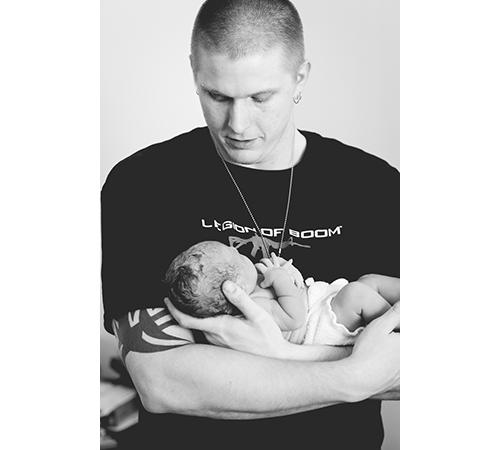
“This dad is holding his newest little girl for the first time,” says photographer Jessica Heksem. “One of my favorite moments to capture – after mom’s face after the birth of their baby – is dad’s reaction. This is something that most moms don’t see because they are having their own bonding moments, so to catch those loving smiles that they have just melts my heart!”
Safe in dad’s arms
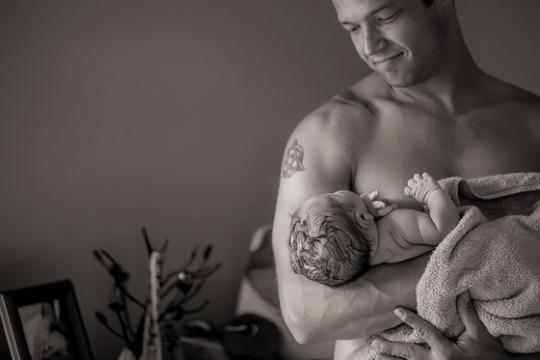
“This image was taken right after this dad witnessed the quick two-hour homebirth of his baby girl,” says photographer Sarah Jankowski. “You could tell he was already so in love with her!"
Making faces

"This funny man is holding his daughter for the first time,” says photographer Tammy Schmit. “As he stared adoringly into her eyes, she stuck her tongue out at him, and he responded in kind."
One-on-one time

"In this photo, dad comforts his brand new baby boy under the warming light,” says photographer Laura Eckert. In fact, according to birth photographers, the warming light is often the first place where dads get to meet and bond with their infant.
Hello there!

“This baby was laid on his mama’s chest as soon as he was born,“ says photographer Casandra Hawkins. "This was the moment his daddy got to see his son for the very first time.” (Photo: Denton Birth Photography)
Catch!
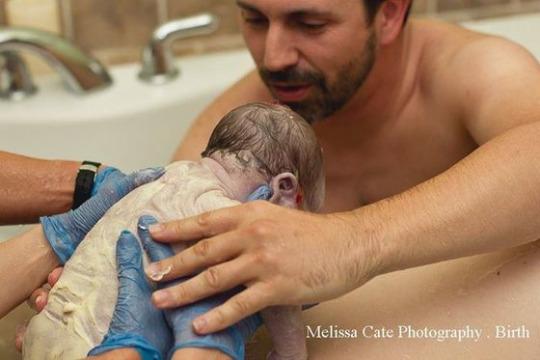
“This daddy is catching his very first daughter,” says photographer Melissa Cate. “Mama delivered in the water on her hands and knees, and baby went directly into Daddy’s waiting arms."
Double rainbow baby

(Photo: Jennifer Mason Photography)
After two losses, this happy and supportive father welcomed his double rainbow baby daughter into the world,” says photographer Jennifer Mason. “His strong wife labored for over 24 hours to bring baby earthside, and this dad was there every step of the way."
The 4 Faces of Fatherhood

"This series of photos embodies everything becoming a father is to me,” says photographer Ashley Marston. “I look at it often, and it brings me right back to that moment. As the photographer, it was hard to keep my camera still. The tears were rolling down my cheeks. I could see the range of emotion in him. It had been a very long and emotional birth, there was relief, then awe, disbelief and then overwhelming love. A lot of the emotions we experience every day as parents — all captured in one very important moment.”
Skin to Skin
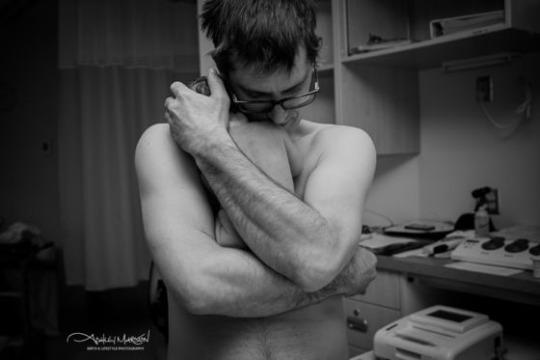
(Photo: Ashley Marston Birth Photography)
“There is no better feeling in this world than that first skin-to-skin contact with your fresh baby,” says photographer Marston. While skin-to-skin is something we typically think of babies doing with Mom, with Dad, it’s just as beautiful.
Holding hands

(Photo: Sabrena Rexing Photography)
In this photo, dad and baby bonded with a little hand holding. “Shortly after coming earthside, this baby grasped onto her father’s finger,” says photographer Sabrena Rexing.
Staring into each other’s eyes
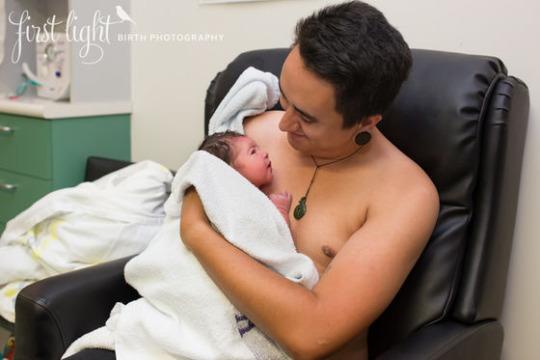
(Photo: First Light Birth Photography)
“This little girl knew exactly who her daddy was and just gazed at him the whole time they had skin to skin,” recalls photographer Keri-Anne Dilworth. “It was such a beautiful moment to capture.”
Love at first sight

(Photo: Cradled Creations)
“The first of many times that father will admire his son,” says photographer Jaydene Freund.
First kiss
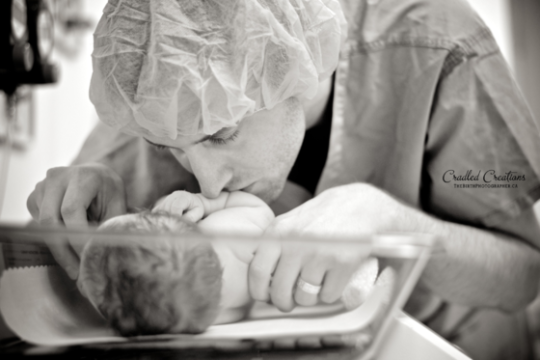
(Photo: Cradled Creations)
This dad had so much love and joy that his son had arrived safely, he leaned over to give a tender kiss while he lay there in the scale,“ says photographer Freund.
Up close and personal

(Photo: Janelle Kamp Photography)
"I love how this dad is getting to know his newborn son, baby Tyson,” says photographer Janelle Kamp.
A life-changing moment

(Photo: Ari Landworth)
“A mother is said to feel like a parent throughout the pregnancy, but the moment a father first holds their child is profoundly life changing,” says photographer Ari Landworth. “This image is intended to impart the gravity of that moment.”
Subscribe to:
Comments (Atom)

